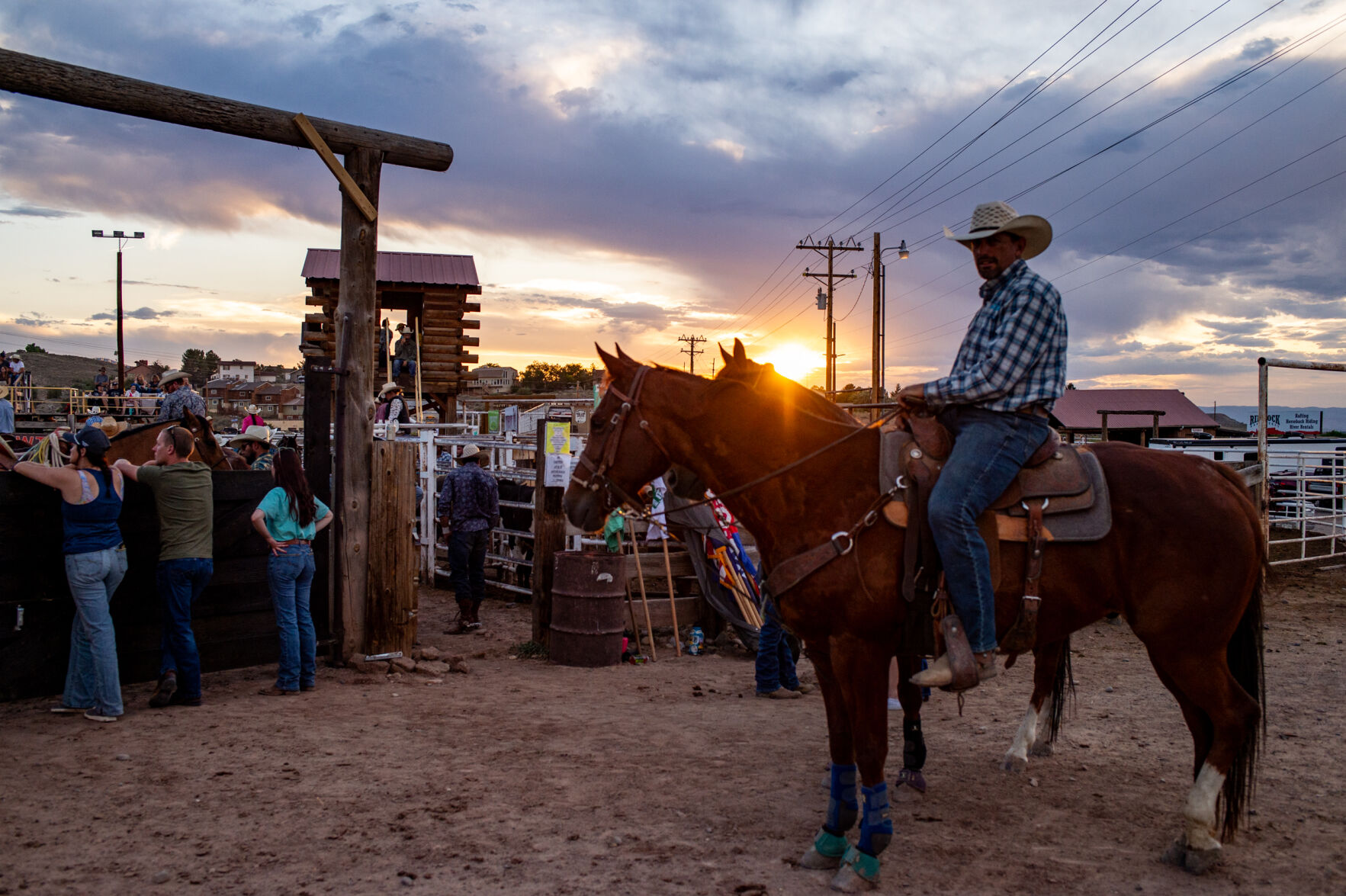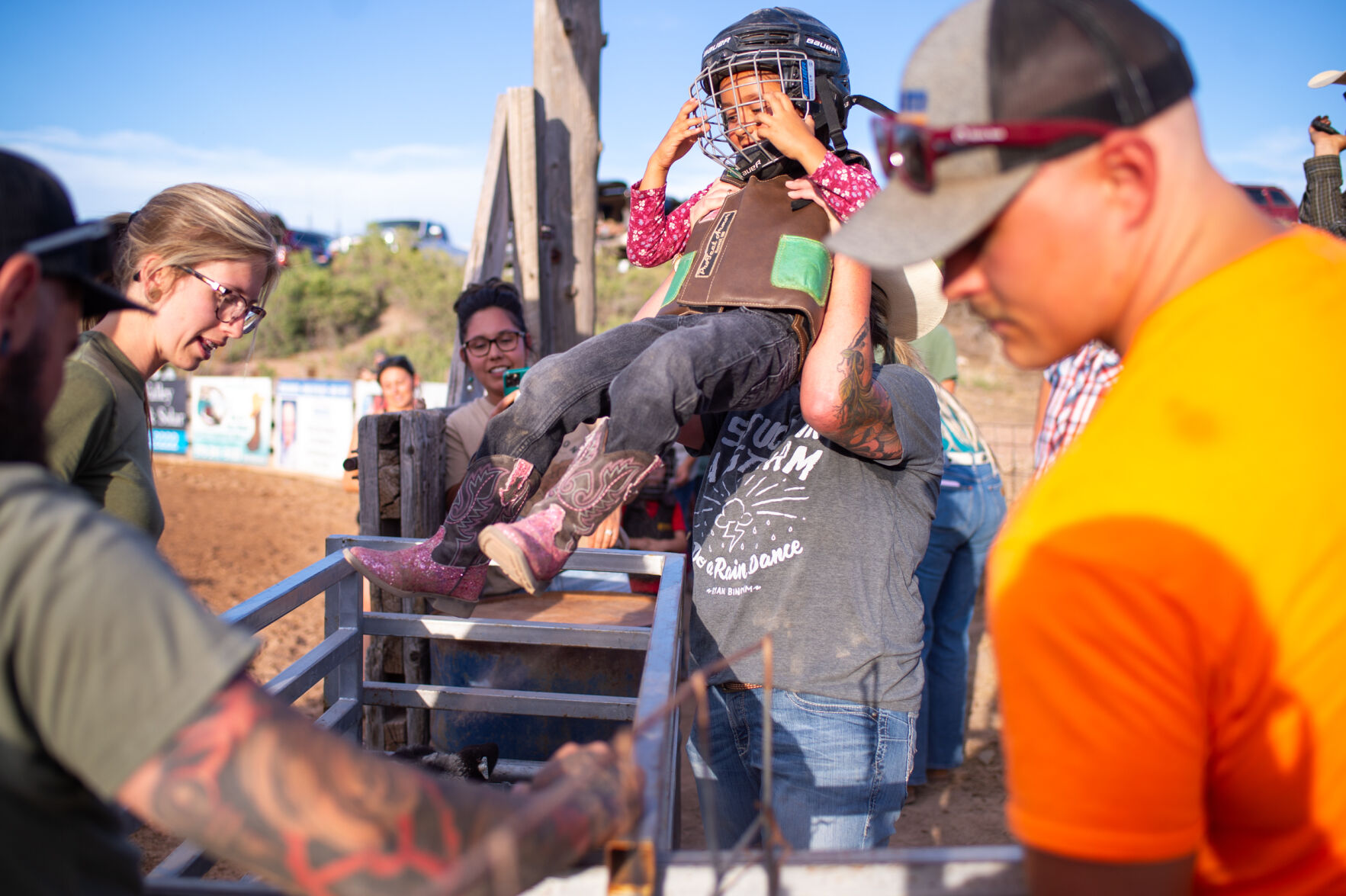Rodeos have long been a tradition in Colorado and all around the West. In fact, the roots of the sport stretch back to before Colorado became a state.
The tiny eastern plains town of Deer Trail, population 1,068 as of the 2020 census, lays (a somewhat contested) claim to having conducted the first rodeo held on American soil, on the Fourth of July, 1869, seven years prior to Colorado’s formal admission to the union. Not long after, similar rodeo precursor events started popping up all over the soon-to-be state, from Boulder to Pueblo to Denver, when the world’s first rodeo to be held at night under artificial light took place in fall of 1890.

The silhouettes of cowboys on their steeds against the light of a setting sun during the Fruita Rim Rock Rodeo on June 10.
There is plenty of evidence to suggest that rodeo-like events were held along the Western Slope that far back, as well. Clippings from the long-extinct newspaper the Denver Republican, which have been preserved by History Colorado, tell of ‘cowboy competitions’ held in Montrose as early as 1887, and various reports claim that the Grand Junction Peach Day festivals of the late 1890s featured ‘cowboy tournaments’ that routinely drew crowds of nearly 5,000 spectators.
It may not be able to trace its roots quite that far back, but with Colorado National Monument looming in the distance in Fruita, the weekly Rim Rock Rodeo is doing its part to preserve the deep history of cowboy culture that this state was founded on.

An American flag is ridden around the rodeo arena during the playing of the national anthem during the weekly Fruita Rim Rock Rodeo on June 10.
For 32 years, families throughout the Western Slope have crowded in to the rodeo grounds at Rim Rock Adventures every Tuesday night to watch roping and riding; in doing so, they’re adding another pattern to the ornate tapestry of cowboy culture right here in town.
”For the majority of the people out here, it’s a lifestyle sport,” local resident Reese Kegans said. “It’s not like a soccer sport, for example. They come out here because that’s what they do for a living, and this is a way to blow off steam and have some friendly competition with your neighbors.”

Larry Robinson/The Daily Sentinel
Team roping competitors rope a steer as locals watch on from the grandstands during the weekly Fruita Rim Rock Rodeo on June 10.
Kegans said that he and his family attend the rodeo almost every week. Recently, his son has begun participating in mutton busting, a rodeo event for youngsters where helmet-wearing children are placed on the back of a sheep and attempt to hold on as long as they possibly can while the sheep begins to run free. Through a mouth stained blue from cotton candy and other concession stand goodies, one youngster confirmed that he’ll be back in the corral next Tuesday to try and bust a mutton again.
”It’s the place to be,” rodeo organizer Jerry Berentis said. “It’s fun, quick, inexpensive entertainment.”

A young mutton buster is lifted onto sheep’s backs before the event during the weekly Fruita Rim Rock Rodeo on June 10. Mutton busting is one way youngsters can get involved in rodeo.
Berentis, himself a lifelong rodeo man, has been the face of the Rim Rock Rodeo for all 32 years of operation. Rodeo lifers like Jerry are still alive and well in the sport, which is a major contributing factor to the sport’s long-term viability. Children whose parents might encourage them into trying mutton busting then grow into teenagers who compete, either in the rodeo or rodeo royalty, or continue to show up as rodeo fans. Those teenagers grow up, have kids, and turn into the parents encouraging their kids to try rodeo. The cycle proliferates.

A cowboy sits atop his steed as the setting Colorado sun shines through clouds above the weekly Fruita Rim Rock Rodeo on June 10.
Lilli Currey is a Loma native who grew up attending the rodeo with her parents every summer. Now, as a high schooler, the rodeo has become a major social event for Currey and her friends to fill long summer nights with. From the bed of her pickup truck, which is parked on the hills overlooking the rodeo grounds, Currey sits alongside her friend, Kaylyn Mason, and takes in the events unfolding in front of them.
”Everyone that’s in Loma needs something other than farming to do,” Currey said. “And so farm kids that I know, they come down and they go to the rodeo.”

Bull riders hit the main stage during the Fruita Rim Rock Rodeo on June 10, 2025.
Then, there’s folks like Tracey Schleich. Tracey and her husband have been attending the Rim Rock Rodeo for the past three years, after her kids started competing in rodeo, her daughter in barrel racing and her son in steer wrestling.
”Our kids just started in rodeo, so this gave us an opportunity to come to a local one,” Schleich shared. “It’s really awesome, because when you do travel a lot for rodeo, to have something closer is a lot easier.”
Schleich said that her kids first got interested in rodeo at the encouragement of their school friends, which is yet another feature of the culture surrounding and protecting rodeo some 150 years after the sport made its way to the United States.
For competitors, Rim Rock is a training ground for other rodeos — that include other weekly venues around the Western Slope like Carbondale and Snowmass.

Team roping competitors rope a steer as locals watch on from the grandstands during the weekly Fruita Rim Rock Rodeo on June 10, 2025.
Over the years, there have been competitors who have started at Rim Rock and gone all the way to major events like the National Finals Rodeo. One of those was Collbran native Ty Wallace, who found bull riding success at the NFR that included a third-place finish in the world championships in 2020.
In many ways, rodeo is the last bastion of the cowboy and Western culture that this state was founded on. A sport borne out of the sense of pride that frontier cowboys had over their professional skills has grown into a cultural fixture that continues to stand long after the days of cowboys riding the desolate prairies have come and gone.

Young mutton busters are lifted onto sheep’s backs before getting let loose across the rodeo arena during the weekly Fruita Rim Rock Rodeo on June 10, 2025.
The deep-seated connections that countless families have to their heritage is enjoyed as they return to the Rim Rock Rodeo every Tuesday all summer long, and it has been for 32 years — proof that this genre of Americana is alive and well.
Whether it’s up-and-coming mutton busters, bull riders, barrel racers, steer wrestlers, team ropers, rodeo lifers, or folks who fall somewhere in between, those who come out to the Rim Rock Rodeo continue to prove that this Western culture and rodeo lifestyle is still king on the Western Slope.

